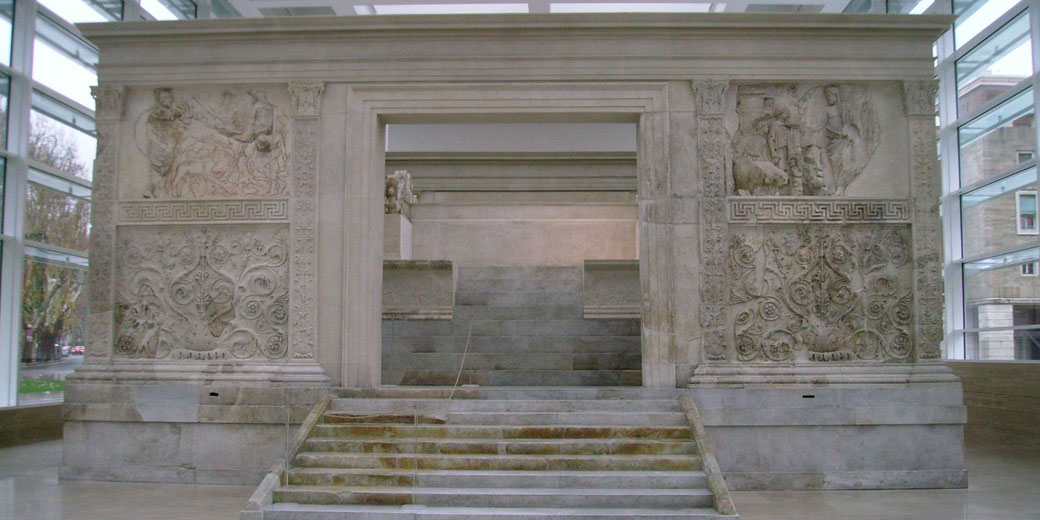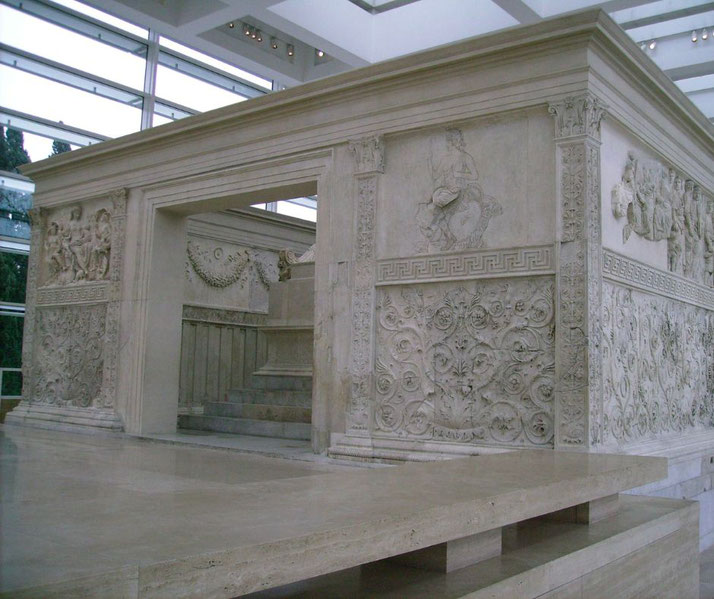The Ara Pacis: The ultimate demonstration of Emperor Augustus' propaganda machine

Commissioned in 13 BCE and completed by 9 BCE, the Ara Pacis Augustae honoured Augustus' return from successful campaigns in Hispania and Gaul.
Although designed as a religious monument, it was also a tool of imperial propaganda that publicly presented peace, fertility, family loyalty, and the divine authority of Augustus.
Through imagery and architecture used in rituals, it helped form public understanding of his rule.
Historical background: The rise of Augustus
Augustus came to power during the violent collapse of the Roman Republic, which followed the assassination of Julius Caesar in 44 BCE.
After he had been adopted as Caesar’s heir in his will, Octavian aligned with Mark Antony and Marcus Lepidus in the Second Triumvirate and defeated Caesar’s assassins at the Battle of Philippi in 42 BCE, although that alliance quickly fractured.
Over the next decade, he neutralised his rivals through warfare supported by calculated marriages and political manoeuvring until his naval victory over Antony and Cleopatra at Actium in 31 BCE gave him uncontested control of Rome.
From 27 BCE onward, he ruled under the title ‘Augustus’ and presented himself as the restorer of the Republic, even though he controlled the army and the state apparatus that administered finances and provincial commands.
He also acquired several prestigious titles, including Princeps Senatus and Imperator.
In 12 BCE, he assumed the position of Pontifex Maximus after the death of Lepidus.
Rather than dismantling existing institutions, he allowed traditional offices to continue operating under his supervision, which helped disguise the concentration of power.
By combining political authority with claims of religious favour, he projected an image of moral superiority that encouraged public loyalty.
To reinforce this perception, Augustus introduced reforms that touched nearly every part of Roman life.
He revived neglected priesthoods, enforced marriage laws among the elite, and embarked on an ambitious temple restoration programme.
According to his Res Gestae, he claimed that he had restored eighty-two temples in a single year.
By connecting himself to Rome's divine past, he had aligned his leadership with the gods’ favour.
At the same time, poets under his patronage, such as Virgil and Horace, composed works that generally supported this new ideology.
As part of this wider campaign, public monuments largely became tools that used images to persuade people, as Augustus carefully selected the sites of temples, altars, and commemorative structures to ensure they told a unified story.
The Ara Pacis formed one significant part of this larger programme, which also included his Mausoleum in the Campus Martius and the Solarium Augusti, a large solar marker aligned with an imported Egyptian obelisk.
Although the Solarium is sometimes referred to as the Horologium of Augustus, it was not a precise sundial in the modern sense.
Regardless, each site contributed to a carefully managed image that connected his rule with divine favour and Rome's foundational myths.

Building the Ara Pacis
On 4 July 13 BCE, the Senate formally decreed the construction of the Ara Pacis to celebrate Augustus’ safe return from Gaul and Hispania.
The altar stood on the Via Flaminia near other Augustan monuments so that all who entered Rome from the north would encounter it.
The monument, which was mainly built from white Luna marble, featured a raised altar enclosed within a square-walled enclosure measuring 11.6 by 10.6 metres.
The enclosure walls displayed richly carved friezes in both high and low relief, which showed a Hellenistic influence adapted to Roman subjects.
A short stairway led to the altar platform, where priests would have performed sacrifices during official religious ceremonies.
Augustus aligned the monument with a solar obelisk that had been transported from Egypt and tied its purpose to a broader heavenly message.
Some ancient sources and modern reconstructions suggest that on his birthday, the shadow of the obelisk may have reached the altar, and scholars debated how exact the alignment was.
Whether exact or symbolic, the association reinforced the idea that his rule brought harmony to both the heavens and the Roman world.
Because the altar combined religious devotion and imperial symbols, it provided both a place of worship and a reminder of political authority.
Romans who witnessed ceremonies at the site often encountered an image of peace that depended on Augustus’ presence and leadership.
Therefore, each feature of the altar, from its imagery to its setting, contributed to a unified message that public stability and proper religious practice could only survive under his rule.
The visual propaganda on the altar
To convey this message clearly, the artists who worked on the Ara Pacis created a series of images that fused myth and family, framed by state ritual.
The north and south walls showed processions of real individuals, including Augustus, Agrippa, Livia, Tiberius, and other members of the imperial family.
The frieze, which showed them in a formal religious ritual, reinforced the idea that Augustus upheld tradition and prepared the next generation to rule.
Rather than inventing purely symbolic figures, the artists included identifiable children and priests who anchored the images in daily Roman life.
Contemporary viewers could often recognise figures such as Gaius and Lucius Caesar, who were Augustus’ adopted heirs, and this gave the procession a focus on the ruling family.
The presence of both men and women in the procession also suggested that family loyalty formed the foundation of a stable empire rather than personal virtue.
On the eastern face of the altar, the goddess Pax, or possibly Tellus or Italia, appeared seated in a fertile setting surrounded by swans, animals, and plants that flourished.
Scholars continue to debate the figure’s exact identity, though most interpretations agree that she symbolised the rewards of peace, which Augustus claimed to have achieved by ending civil war.
On the adjacent panel, the goddess Roma sat on a pile of weapons, guarding them beneath her as a sign that peace now prevailed under imperial control.
Further propaganda appeared on the western side, where sculptors depicted Aeneas sacrificing at an altar.
This scene was drawn from Rome’s mythic beginnings and was meant to reminded viewers that Augustus traced his lineage to Aeneas and therefore to Venus.
Another relief on the same wall showed Romulus and Remus with the she-wolf and the shepherd Faustulus.
That imagery placed the origins of Rome beside the founding of the imperial family, uniting past and present.
When these symbols were wrapped around a sacred space, the monument invited viewers to accept that Augustus continued the work of Rome’s founders and fulfilled their vision.
Finally, sculpted garlands, sacrificial implements, and ox skulls lined the interior walls to suggest a ritual setting filled with divine approval.

The relocation of the Ara Pacis over the centuries
After the decline of the Western Roman Empire, the Ara Pacis gradually disappeared beneath silt and mud deposited by repeated flooding from the Tiber River.
The Campus Martius lost its ceremonial function and became a densely built urban district, while knowledge of the monument’s location faded from collective memory.
However, fragments began to reappear during construction work, and collectors and early scholars took interest in preserving them.
From the Renaissance onward, scholars and artists recorded marble panels and reliefs found around the area of the former altar.
As they compared these fragments with ancient texts and stylistic patterns, some began to suspect their origin.
In 1879, Friedrich von Duhn provided the first scholarly identification that linked the fragments to the Ara Pacis, which prompted a more systematic investigation and excavation.
During the 1930s, Mussolini ordered a full-scale excavation and reconstruction of the monument as part of his effort to connect modern Italy to the Roman past.
His regime removed structures covering the buried altar and retrieved as many fragments as possible.
These pieces were reassembled into a display building near the Mausoleum of Augustus, and the entire project became part of Fascist propaganda that praised imperial Rome.
The reassembly was timed to coincide with the 2,000th anniversary of Augustus’ birth in 1938, and slogans at the time equated Mussolini with Augustus appeared near the monument.
When preservation standards improved, a new project began to house the altar in a modern museum space.
The Museo dell’Ara Pacis, which was designed by American architect Richard Meier and completed in 2006, now provides a permanent home for the structure with proper lighting and climate control and allows for effective explanatory signs.
While the modernist design proved controversial due to its contrast with Roman style, the location near the original site ensures that the monument can still be studied in relation to the layout of Augustan Rome.
What do you need help with?
Download ready-to-use digital learning resources
Copyright © History Skills 2014-2025.
Contact via email
With the exception of links to external sites, some historical sources and extracts from specific publications, all content on this website is copyrighted by History Skills. This content may not be copied, republished or redistributed without written permission from the website creator. Please use the Contact page to obtain relevant permission.





